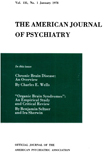AN INQUIRY INTO EIDETIC IMAGERY WITH PARTICULAR REFERENCE TO VISUAL HALLUCINATIONS
Abstract
This inquiry is an attempt(1) to obtain experimental evidence concerning the nature of eidetic imagery in alcoholic subjects with histories of visual hallucinations, and (2) to determine the relationship between eidetic and hallucinatory phenomena.
A group of 40 alcoholics (20 experimental and 20 control) were submitted to fixating and nonfixating periods on homogeneous and heterogeneous stimuli. The results were used to compare the existing differences between the 2 groups.
1. Eidetic images were reported by 3 subjects in the experimental group and none in the control group.
2. The after-images elicited by a 20-second fixated exposure of the homogeneous stimulus, reported by both experimental and control subjects, did not possess any significant qualitative or quantitative differences.
3. Eidetic images were reported one hour after exposure to the silhouettes by all 3 eidetic subjects but showed a decrease in mean duration and number of details.
4. The memory images of 20 control subjects were richer in detail than the eidetic images of the 3 experimental subjects.
5. The probability value of 11% for the experimental results is not significant and indicates the proportionality ratio of eidetics to noneidetics is a result of sampling variation.
These results do not statistically substantiate the hypothesis of a relationship between eidetic experiences and visual hallucinations. Neuroanatomical and physiological approaches to this problem have brought forth confirmatory evidence indicating a close phenomenological relationship between hallucinations and eidetic images.
It is not the purpose of this paper to equate the term hallucination with a genetically different phenomenon. The fact that the eidetic image is never confused with reality has been the differentia specifica between vivid mental images and hallucinations. One may say that hallucinations are mental images experienced in pathological states, while eidetic images are a consequence of a specific sensory endowment.
Both the context and structure of visual hallucinations in alcoholics may be determined by the particular optic or brain centers affected by the drug, by the psychophysical make-up of the individual, and by intrapsychic and environmental experiences.
Pending further follow-up studies, it appears that this experimental analysis shows that an eidetic endowment is not essential to the development of visual hallucinations in alcoholics.
Access content
To read the fulltext, please use one of the options below to sign in or purchase access.- Personal login
- Institutional Login
- Sign in via OpenAthens
- Register for access
-
Please login/register if you wish to pair your device and check access availability.
Not a subscriber?
PsychiatryOnline subscription options offer access to the DSM-5 library, books, journals, CME, and patient resources. This all-in-one virtual library provides psychiatrists and mental health professionals with key resources for diagnosis, treatment, research, and professional development.
Need more help? PsychiatryOnline Customer Service may be reached by emailing [email protected] or by calling 800-368-5777 (in the U.S.) or 703-907-7322 (outside the U.S.).



